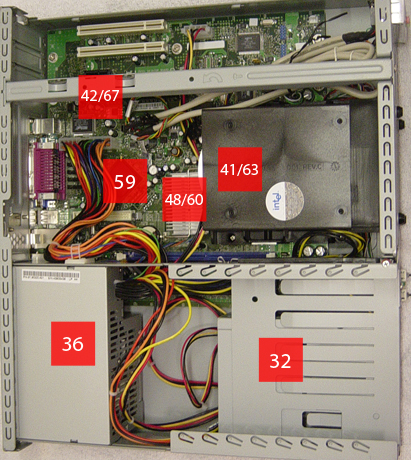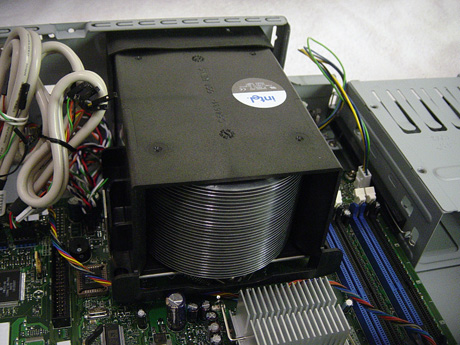Intel's Long Awaited BTX Form Factor
by Purav Sanghani on November 15, 2004 5:31 AM EST- Posted in
- Cases/Cooling/PSUs
Thermals Micro BTX (uBTX)
This is where everything we have heard about the BTX form factor is either proven right or wrong. Intel claims BTX the better design to efficiently cool more components with less equipment while using less power and space. Intel released a virtual press kit on their BTX form factor in April of this year. Unfortunately, the press kit is a little too general to really draw many conclusions, but feel free to judge for yourself.Intel's press kit reports that the BTX design cools the CPU to 2 degrees lower than the ATX form factor while only providing 40 cubic feet per minute, or 40 cfm with our Type I Thermal Module. ATX, on the other hand, requires 150 linear feet per minute, or 150 lfm.
We performed our inch by inch temperature observation with the D915GMH microBTX motherboard and the Pentium 550 CPU in the AOpen B300 which is 15" in width by 13" in depth.

Click to Enlarge
From our results above we see that the temperatures of each square inch of the case are a few degrees higher than those we found on our ATX Ahanix D.Vine 5 chassis. The warmest pocket of air hovers between the PCIe card, Southbridge, Northbridge, and CPU. This area, which averages about 35 degrees, is warmer than the ATX ambient average of about 32 degrees. Intel's whitepaper was not clear on the equipment they used to get the results in their table but from our results, the standard ATX system performs cooler than the BTX system. The microATX system, however, produced temperatures higher than those of the microBTX system.

Click to Enlarge
The results for the core temperatures of each component shown above also tell us that the microBTX equipment does not exactly perform better than the ATX hardware, but for the amount of fans in the system, microBTX is more efficient when it comes to cost of energy and space. With only the CPU's HSF and the power supply's single 80mm fan, the uBTX system performs at temperatures lower than an uATX system with three case fans and a dedicated CPU HSF.

Click to Enlarge
These temperatures are not set in stone for every processor Intel manufacturers or will release in the future. Each will require a different thermal module according to their Thermal Design Power rating. For example, The Pentium 550J will come bundled with a Type I Stacked-fin module whereas the Pentium 560J will come with the Type I Spiral-fin module. Obviously the spiral-fin module will dissipate heat better than the stacked fins.










77 Comments
View All Comments
L3p3rM355i4h - Thursday, February 10, 2005 - link
Seems to be good for the OEM market, but what about us people who *actually* care about computers? Front exhuaust has to be the stupidest thing ever. Why was it so hard just to reverse the layout, so it would be atleast somewhat compatable with the current ATX standard.And the guy/gal who made up the "ATX II" standard, maybe you should contact AMD or someone. They might be interested.
EthernaL - Friday, May 19, 2006 - link
What if I really LIKE my BIG ATX tower?Maybe I have temperature problems in summer... maybe is not all the efficient that could be but I really love this design and I don't want to move to a small design and I don't want to buy the whole thing again.
Another nice thing with the computers we currently have is the possibility to give our friends/relatives old pieces once we upgrade our computer (my sister's computer is build that way :P )
So, again, another decission based ONLY on money without thinking in what we (the users) want or need. Thanks Intel, I hate you more than ever, and if you 'force us' to move to that technology I hope your business will go bankrupt.
IntelUser2000 - Sunday, November 21, 2004 - link
"From the picture we see the flow of air pushed back through the CPU thermal module towards the Northbridge, Southbridge, and VGA card. As this air flows around the CPU, it warms up, as we can see from the red areas to the left and right of the CPU. This warm air then flows over the Northbridge and seems to cool as it travels further back in the chassis. At the left we see the channel of air flowing to the left over the memory and out through the PSU. The channel on the right flows straight back to the VGA card and out through groups of holes in the back of the case."Well doesn't look like to me that hot air comes out front.
MadAd - Friday, November 19, 2004 - link
One question im having in my mind is how big of a paintbrush will i need to get inbetween those fins - talk about a dust trap.At least a majority of atx heatsink designs have easy to clean fins, and boy do they need cleaning sometimes, this is going to be worse.
Cue the repair calls in years to come, $50 an hour for removing wads of the customers cat/dog/children from around the cooler after the safety backoff system renders the machine temporatily gonadless.
epiv - Thursday, November 18, 2004 - link
Intel can and should make BTX backward and forward compeitable with ATX so we can decide if a new BTX case and PSU is worth the money.I am a poor student and I already spend money on a good case and PSU. My case should be able to handle more heat than a regular BTX case. I really hope I will not have to get a new case and PSU when I upgrade my computer.
trikster2 - Wednesday, November 17, 2004 - link
facts? I actually own the silverstone version of the oppus case, so I am actually speaking from experience. Vertical vs horizontal lowprofile vs full height has a lot to do with heat disapation
Myrandex - Tuesday, November 16, 2004 - link
I wonder how BTX had a NDA because Gateway has been selling BTX computers at best buy for over a month at leastCygni - Tuesday, November 16, 2004 - link
Dont you bring facts into this, Kris! Trikster2 doesnt want any of that!KristopherKubicki - Tuesday, November 16, 2004 - link
trikster2: The Opus case was chosen because it was the same volume as the mBTX case. I don't really see how a mATX tower and an mBTX case are going to differ significantly.Kristopher
ceefka - Tuesday, November 16, 2004 - link
How can this possibly translate into lower cost for end users? Thank you, Intel.I am also disappointed by Intel's approach. Uhm, we have a hot CPU; let's make a cooler case!
Since they invented this in their own backyard without creating a wide support it looks like an ego-trip.